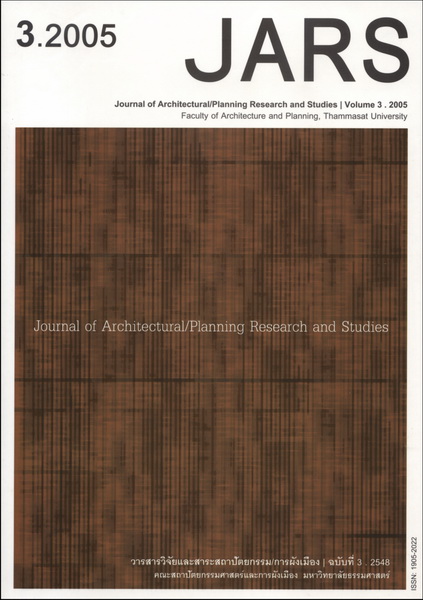The Future of Cultural Heritage Conservation amid Urbanization in Asia: Constraints and Prospects
Main Article Content
Abstract
Given the national commitments and the international criteria for nomination of cultural properties
and cultural landscapes to be inscribed on the World Cultural Heritage List, and various threats from
multiple external forces as well as intrinsic constraints among Asian countries, this study then attempts
to investigate the significant variables, their applicabilities to and impacts on conservation implementation
and potential performances. Through reviewing conservation experiences in Asian regions, critical
constraints and prospects in terms of positive approaches are explored together with demonstrating
distinctive examples of World Cultural Heritage and Asia-Pacific’s best practices in conservation. The
outputs of these investigations set up the conceptual framework of challenge for escalating the conservation
movements in Thailand.
Downloads
Article Details

This work is licensed under a Creative Commons Attribution-NonCommercial-NoDerivatives 4.0 International License.
All material is licensed under the terms of the Creative Commons Attribution 4.0 International (CC-BY-NC-ND 4.0) License, unless otherwise stated. As such, authors are free to share, copy, and redistribute the material in any medium or format. The authors must give appropriate credit, provide a link to the license, and indicate if changes were made. The authors may do so in any reasonable manner, but not in any way that suggests the licensor endorses you or your use. The authors may not use the material for commercial purposes. If the authors remix, transform, or build upon the material, they may not distribute the modified material, unless permission is obtained from JARS. Final, accepted versions of the paper may be posted on third party repositories, provided appropriate acknowledgement to the original source is clearly noted.
References
United Nations Educational, Scientific and Cultural Organisation, Convention Concerning Protection of the World Cultural and Natural Heritage. Adopted by the General Conference at its seventeenth session Paris, 16 November 1972, Article 4.
United Nations Educational, Scientific and Cultural Organisation, Intergovernmental Committee for the Protection of the World Cultural and Natural Heritage, World Heritage Centre. (2002). Operational Guide lines for the Implementation of the World Heritage Convention. Paris: Unesco World Heritage Centre, 6-7.
William S. Logan. (2002). The Disappearing ‘Asian’ City: Protecting Asia’s Urban Heritage in a Globalizing World. Hong Kong: Oxford University Press.
Completed by King Kyanzittha who came to power in 1084, the Shwezigon in Pagan was later undergone additions and restoration works by a variety of subsequent benefactors. See Fiona Kerlogue (2004). Arts of Southeast Asia. London: Thames & Hudson, 112-114.
The 8th Regional Office of Fine Arts, Chiang Mai. (2004). Wiang Kum Kam: The Dawn of Nop Buri Si Nakhon Ping Chiang Mai. Chiang Mai: Wiang Kum Kam Information Center.
Phuket Municipality. (2002). Old Phuket: Our Heritage, The Development & Conservation of Old Commercial Quarter in Phuket Town. Commemoration of the 5th Old Phuket Town Festival, 21-22 December 2002.
Reference 1, Article 15-26. Also Reference 2, 35-36.
Vimolsiddhi Horayangkura. (2002). Toward Generating Modern Thai Architecture, in Traditional Architecture in Modern Asia. Proceedings of 2002 Seoul International Conference on East Asian Architectural History, held at Seoul National University, Seoul Korea, by Korean Association of Architectural History, October 17 - 19, 2002, 205-216.
Extensive discussions on the Asian context of Globalization and Post-Modernity are dialectically presented in William S. W. Lim. (2003). Alternative (Post) Modernity: An Asian Perspective. Singapore: Select Publishing.
United Nations Educational, Scientific and Cultural Organization (2004). Asia Conserved: Best Practices from the UNESCO Asia-Pacific Heritage Awards for Culture Heritage Conservation (2000-2004).
Siriporn Nanta (Ed.) (2002). Thai Heritage - World Heritage. Bangkok: Fine Arts Department, Ministry of Education, 8-41.
Michael Waible. (2002). Saving the Vitality of the Ancient Quarter: Some Findings from the SocioEconomic Point of View of a Geographer, presented to Goethe Institute Conference Series on Urban Conservation - A Comparative View of Southeast Asia. International Symposium organized by Goethe Institute of Hanoi in cooperation with the Technical University Darmstadt and the Hanoi University of Civil Engineering, Hanoi, 4th - 5th October 2002, 1.
Mike Meyer, Backstreet Beijing: Get to the Chinese Capital’s Old Alleys, or Hutongs, before the Developers Do. Time. October 18, 2004, 60. Journal of Architectural/Planning Research and Studies Volume 3. 2005 Faculty of Architecture and Planning, Thammasat University 84
Dai Ming and Wu Zhengwang. (2004). Rethinking of the Reservation Strategy of Historical Architecture Heritage in the Urbanization Process, Proceedings of International Conference on East Asian Architectural Culture on History & Future of Architectural Heritage in East Asia (HFAH 2004). held by School of Architecture, Southeast University, Nanjing, 6th - 8th November, 2004, 703-709.
David Morey and Scott Miller. (2004). The Underdog Advantage. New York: McGraw-Hill.


